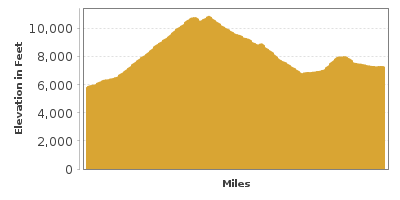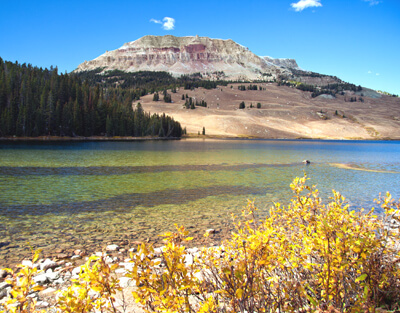Beartooth Highway
America’s Most Scenic Road
| Mileage | 69 miles (111 km) |
|---|---|
| DurationThe duration is an estimate of a one-way drive and does not include any stops or side-trips. | 1 hour, 17 minutes |
| SeasonsThe seasons listed are the best seasons for this scenic drive. If Winter is not mentioned, the road may be closed during the winter. | Summer, and Fall |
| Roadways | US Highway 212 |
| ServicesThe cities or towns listed have either Food or Services such as gas, pharmacies, etc. | Red Lodge, MT▼, Cooke City, MT▼, and Silver Gate, MT▼ |
| Rating | 4.1 average from 78 votes |
| My DrivesTrack your favorite scenic drives by selecting those which you want to take and those that you have taken. Using your free account, simply sign in and select My Drives. | |
| Share |
Our free Road Trip Planner will reverse the route and include the places of interests. Click the “Add to Road Trip” above to start planning your next road trip.
Send this link to your phone. Standard text messaging rates apply.
() -Get directions from your start address to the beginning of and including this scenic drive. Choose either an alternate ending or same as start.
Have more destinations? Use our free Road Trip Planner to completely plan your adventure. Click the “Add to Road Trip” above to start planning your next road trip.

From lush forests to alpine plateaus and more than 20 mountain peaks above 12,000 feet, Beartooth Highway covers some of the most spectacular scenery in the continental United States.

Our scenic drive begins in the town of Red Lodge, a mining town that used to extract coal from the foothills of the Rockies back in the 1880s. From I-90, we recommend you take exit 408 and follow the signs for MT-78 for a scenic drive along the edge of the Beartooth Mountains, along Stillwater River Canyon and East Rosebud Creek on your way to Red Lodge. If you are short for time, exit 434 will bring you to Red Lodge via the US-212.
As you approach the town of Red Lodge, you will clearly see Beartooth Plateau. Formed 50 million years ago and smoothed and shaped by a glacier, it is the tallest plateau in the United States. In town, stroll the historic district with a self-guided walking tour which explores the site of Sundance Kid’s 1897 bank robbery, the mining boom, Victorian architecture and many buildings on the National Historic Register. Or visit the Yellowstone Wildlife Sanctuary (A1), home for animals unable to care for themselves in the wild. Red fox, grey wolf, mud turtle and mountain lion are some of the over 70 residents. During winter, ride up to the Red Lodge Mountain Ski Area.
Heading south on US-212 along the Rock Creek, you soon enter the dense forests of Custer National Forest through which you will see an occasional glimpse of a mountain peak or pinnacle. Take advantage of the many overlooks to enjoy the jaw-dropping scenery that unfolds at every bend.
About 12 miles from Red Lodge, the road leaves Rock Creek and you are rewarded with some spectacular mountain views, particularly in the curves of the switchbacks that climb up to Beartooth Pass at 10,947 feet of elevation.
Climbing the switchbacks, stop at the Rock Creek Vista Point Overlook (V1). At 9,190 feet, behold spectacular views of Rock Creek Canyon, Hellroaring Plateau elevation and the twisting road below. Take the short, wheelchair accessible interpretive trail to the overlook. Mountain goats and bighorn sheep are frequent visitors, so keep an eye out for them.
Continuing southwest, above the tree line, you are surrounded by an alpine tundra environment. Views of the rolling hills, Beartooth Mountains and lakes will take your breath away. Take advantage of the overlooks along this wonderfully windy road.
As you continue, you’ll see the volcanic Absaroka Mountains rising to the southwest. Wildflower-filled meadows of Lupine, Indian Paintbrush, Fringed Gentian and more welcome you with color. Stop at Gardner Lake Overlook (V2) for never-ending expansive views. A mile up the road is a lake and the beginning of the 10-mile Beartooth Loop National Recreation Trail, which explores the alpine tundra. Harsh weather and 45-day growing season make plant and animal life difficult. Only small, tenacious plants adapted for the environment survive. Marmots, mountain goats, pikas, and squirrels live here year round, while grizzlies and bighorn sheep escape the harsh winters.
The 10,947 foot summit of Beartooth Pass is the highest point of this road. Take advantage of the pullouts to explore the alpine environment, 360 degree views, and sometimes drastic weather conditions on one of the highest roads in the world. On a clear day, you can see as far as 75-miles away. Look north to see the rocky peak for which the Beartooth Mountains are named. Absorb the indescribable beauty of glacier carved cirques, alpine lakes and fragile tundra.
From here, the road descends, passing through alpine meadows dotted with lakes, popular spots for anglers, picnics and for those wanting to bask in the incredible surroundings a little longer. Or stay overnight at one of the campgrounds such as Island Lake (W1).
After passing Island Lake, the jagged Pilot Peak and Index Peak both above 11,000 feet, come into view to the west. Shortly after, the road descends to the treeline. In 1.5 miles, the trees open up to the pristine Beartooth Lake (W2) dominated by the blunt-topped 10,514-foot Beartooth Butte. Beartooth Butte was once the floor of a seabed and fossils can be seen. On the south side of the road, keep an eye for 100-foot Beartooth Falls which cascades through the canyon. Part of the Shoshone National Forest, the lake offers boating, camping and hiking.
Stop at the Top of the World Resort (I1), were you can stock up on essentials such as groceries, snacks, souvenirs, books and maps as well as fishing licenses and gas. If you’re looking for adventure, you can rent mountain bikes, paddle boats, canoes and snowmobiles.
Heading west for another mile, consider taking the 2.6-mile gravel road on the right to Clay Butte Lookout (T1). The fire tower provides a stunning view of Montana’s Beartooth, Bighorn, and Absaroka Mountains. To the northwest is the highest point in Montana, the 12,799-foot Granite Peak.
Winding down, the next 6-miles travel through meadows and forest, arriving at the Pilot and Index Overlook (V4) which also offers a wonderful view of the northeast corner of the Absaroka Mountains, formed by volcanic debris accumulation that began 50 million years ago.
Shortly up the road, the US-212 meets the WY-296, commonly referred to as the Chief Joseph Scenic Highway. While the official scenic drive continues west along the US-212, consider following the Clarks Fork Yellowstone River with the WY-296. Here you will see the 1,200-foot deep gorge and Sunlight Basin, 50,000 acres of rolling hills dotted with willows and creeks and enjoyed by a variety of wildlife.
Heading west on US-212 for another 5 miles, you pass over a bridge and to the right, is the Lake Creek Waterfall. Stop after the bridge to take a closer look at Lake Creek (W3) and its falls via a 200-yard hike on a footbridge.
From here, the road parallels Clarks Fork River through the remains of a forest that burned in 1988. The road crosses back into Montana, over Colter Pass, and you soon arrive in the picturesque town of Cooke City. Continuing west, you soon enter Yellowstone National Park where a different adventure awaits.
Other Nearby Places of Interests
Carbon County Historical Society Museum (M1): Take an in-depth look at Red Lodge’s colorful history at the Carbon County Historical Society Museum.
Stillwater River Canyon (T2): From Columbus (exit 408 off I-90), follow MT-78 along the Stillwater River and the canyon. Continue from Absarokee on MT-420 to continue along the canyon and the Stillwater River.
East Rose Bud Lake (T3): From Roscoe, head south on MT-177 to East Rosebud Lake where pine forests and mountain slopes await hikers.
Chief Joseph Scenic Byway (T4): WY-296 is known as Chief Joseph Highway. Following the Clarks Fork Yellowstone River, you will see the 1,200-foot deep gorge and Sunlight Basin, 50,000 acres of rolling hills dotted with willows and creeks and enjoyed by a variety of wildlife.
West Summit Overlook (V3): West Summit Overlook provides a stunning view of the windy roads as it climbs over Beartooth Peak.





